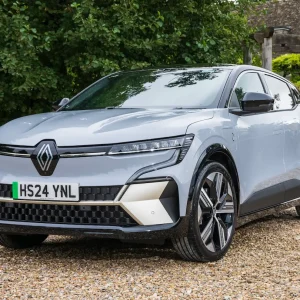Volkswagen Transporters are cool – period. However, change is afoot as the incoming T7 is likely to share a great deal with the new Ford E-Transit, thanks to a manufacturer tie-up. Plus, instead of an MPV version of the new van, the former Caravelle becomes the Multivan that we have here.
More interesting is that despite being van-shaped, underneath, the Multivan is based on Volkswagen’s popular MQB car architecture. This also underpins other group models, such as the Audi A3 and Cupra Formentor.
Another fleet attraction is the addition of a new plug-in ehybrid version – which we’ve got here. This combines a 150hp petrol with a 115hp electric motor, both at the front, for 215hp, a quoted EV range of 30 miles and a BiK of 12% and just 41g/km emissions meaning it’s sure to be a hit with fleet. Other Multivan engine options include a 2.0-litre diesel with 150hp, plus a 135hp 1.5-litre and a 204hp 2.0-litre petrol.
Outside, the Multivan might look familiar, but the design is all new and looks sharp. The biggest change being the ID Buzz-like, cab-forward design, with the large windscreen and quarterlights. Then there are the slim lights and light bar, which reminded us of the current Golf. With the lower grille and airdam that’s more like the Buzz.
Our Multivan was finished in two-tone Mono Silver at the top, with Energetic Orange for the lower half. This is an expensive option at £2,700 but it suits a vehicle that’s not taking itself too seriously. The other big giveaway that it’s a hybrid is the extra filler on the right-hand front wing. Our car was fitted with the biggest 17in alloy wheels, but in our opinion, they looked rather lost under the arches.
At the back, again there are high-set, slimline rear light clusters that eat into the rear quarters and on our test vehicle, neatly merged into the chrome trim on the waistline. Another rear highlight is the distinctive, chunky rear spoiler.
Inside, one of the best parts of the last Caravelle was its interior flexibility and you’ll be pleased to know this is unchanged in the Multivan, with Standard and Long-wheelbase versions available. All the five-seats in the two-rows were thoroughly road tested by my children during the week we had this van. They were impressed at how easy the seats were to move, recline and fold. We were told they were easy to remove too, although we didn’t try. There was also a sliding centre console, which can be raised to the height of the seats with practical fold out tables. We’d say if you’re regularly carrying five passengers, we’d probably opt for the long-wheelbase version, as space was a bit tight in the third row of seats. Boot space is 469 litres with all the seats in place; remove them all and this jumps to 3,672 litres.
In the front, the driving position is tall but comfortable. The dashboard design echoes Volkswagen’s car range, with little switchgear and what there is, is grouped in the centre or to the driver’s side. A rear camera and parking sensors help with parking and manoeuvrability, but the thick front windscreen pillars hurt visibility when pulling out of junctions or turning.
It is a shame then, that like the rest of the Volkswagen range, the Multivan has the same infotainment system that is as difficult as ever to operate when using simple functions.
Fully charged, we couldn’t quite match Volkswagen’s claim of 30 miles of EV only power, instead we saw just 15. Then it smoothly shifted to 1.4-litre petrol power, which despite its small size didn’t feel outpaced in the Multivan’s boxy body and 2,750kg weight. On the road, the MQB underpinnings make themselves known, with precise steering and tidy handling. This Volkswagen rides well, too. The only demerits of an otherwise impressive driving package was some drivetrain shunt when the battery was empty and it was shifting from petrol to electric power. Plus, an odd feel to the brakes on some occasions, when its re-gening while braking.
Sister van, the all-electric ID.Buzz will get all the attention of course, because of its modern retro looks, but if EV power doesn’t work, the Multivan still looks sharp, is impressively practical and surprisingly good to drive and in hybrid form, should prove cheap to run – although it’s not cheap to buy.
Volkswagen Multivan Life 1.4TSI eHybrid
P11D: £48,828
Residual value: 58.7%
Depreciation: £20,148
Fuel: £9,318
Service, maintenance and repair: £2,088
Cost per mile: 52.59p
Fuel consumption: 156.9mpg
CO2 (BIK %): 41g/km (12%)
BIK 20/40% a month: £97/£195
Luggage capacity: 469 litres
Engine size/power: 1,390cc + 85kW electric motor/218hp





